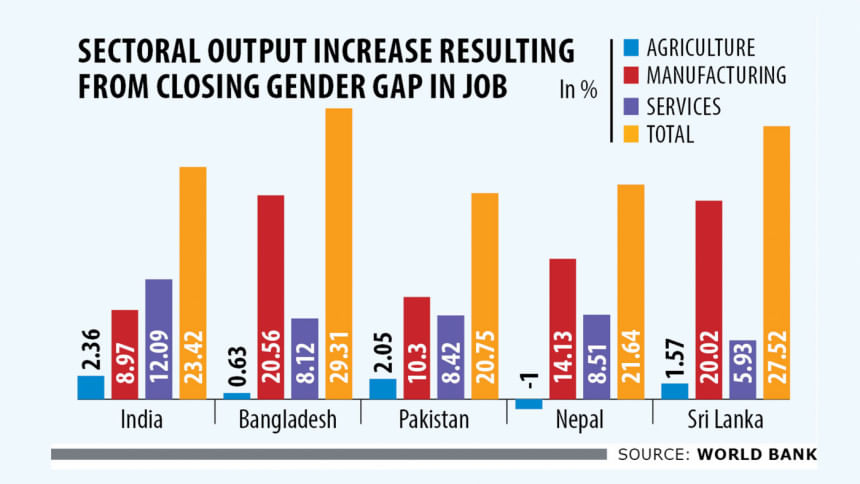Economic output may expand 29% if more women employed: WB

Bangladesh could increase its output in the manufacturing, service and farming sectors by up to 29 percent simply by bringing more women into the workforce, according to the World Bank.
The increase would be the highest among South Asian countries due to Bangladesh's relatively higher initial labour productivity.
If more women were to access manufacturing jobs alone, output in Bangladesh could rise by as much as 21 percent, the Washington-based lender said in its South Asia Development update published last week.
Despite progress in the local garment industry, the report shows a sizable gender gap in employment across the broader manufacturing sector.
The report said the female labour participation rate in Bangladesh remained static at 37 percent in 2022 and 2023.
It identified supply-side constraints, restrictive laws and conservative social norms as factors deterring more women from joining the labour force.
Economists agreed with the World Bank's projection, citing the country's apparel might with female labour force at its core. However, they also listed demand-side factors that discourage more women from participating in the workforce.
"Employers are often hesitant to hire women," said Professor Selim Raihan, executive director of the South Asian Network on Economic Modeling (Sanem). "Many firms still do not have women-friendly production processes or workplace arrangements."
According to the report, if more women joined farming in Bangladesh, only modest gains of 0.63 percent could be expected due to low labour productivity and a smaller gender gap in employment.
However, closing the gender gap could lead to a gain of 8.12 percent in the service sector.
The Sanem executive director said the task of caring for children and elderly persons falls disproportionately on women, acting as a supply-side factor that limits employment opportunities.
"To increase women's participation in employment, both supply-side and demand-side constraints must be addressed," he remarked.
"Safety and security issues also contribute to the lower participation," the economist added. "The availability of transportation for women is also important. The government should take care of these issues."
The World Bank said Bangladesh has the least protective laws for women, leading to severe shortcomings in safety. According to the report, Bangladesh and Pakistan also have the most conservative social expectations for women.
Frustrating participation shadows promising outlook
The report said the female labour force participation rates in most South Asian countries are in the bottom quartile among emerging and developing countries and far below male participation rates.
"South Asia's female labour force participation rate of 32 percent is well below the 54 percent average in emerging market and developing economies," said Franziska Ohnsorge, World Bank chief economist for South Asia.
However, this contrasts with the share of female employment in a range of export-oriented sectors across South Asia, such as ready-made garments in Bangladesh, call centres in India, and textiles in Sri Lanka.
The multilateral lender said increased female participation in the workforce could boost India's output by 23 percent, Pakistan's by 21 percent, Nepal's by 22 percent and Sri Lanka's by 28 percent.
If more women were to access manufacturing jobs, output in India would rise by 9 percent, it said.
Low female employment means a substantial loss of aggregate and per capita incomes. Raising women's labour force participation rate to parity with men would increase regional GDP by 13–51 percent, with larger impacts if capital and labour markets are more flexible, it said.
"South Asia's outlook is undoubtedly promising, but the region could do more to realise its full economic potential," said Martin Raiser, World Bank vice president for South Asia.
World Bank Chief Economist for South Asia Franziska Ohnsorge said, "Increasing women's employment requires action from all stakeholders; a multi-pronged effort where governments, the private sector, communities and households all have a role to play."
Echoing these sentiments, Raiser said key policy reforms to integrate more women into the workforce and remove barriers to global investment and trade could accelerate growth.


 For all latest news, follow The Daily Star's Google News channel.
For all latest news, follow The Daily Star's Google News channel. 








Comments